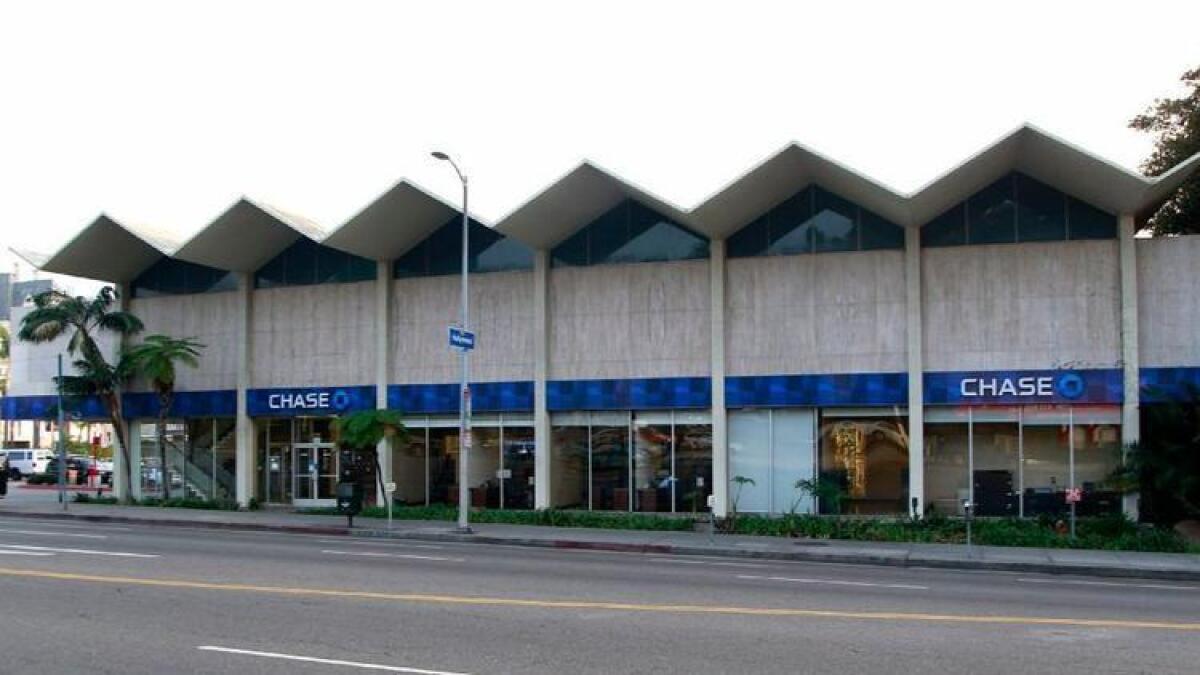L.A. Conservancy wins round in its bid to stop demolition of Googie-style bank building

A judge dealt a setback this week to the plan for a Frank Gehry-designed mixed-use complex in Hollywood, saying Los Angeles leaders failed to comply with the stateâs environmental review process when they approved the project.
In a 55-page ruling, L.A. County Superior Court Judge Amy D. Hogue said the City Council had failed to make the required legal findings before signing off on demolition of an architecturally significant bank building on the Sunset Boulevard site.
The decision delivered a victory to the Los Angeles Conservancy, a historic preservation group pushing to save the Lytton Savings building, a 1960 structure known for its zigzag roof. Conservancy leaders said Hogueâs decision should prompt a redesign of the Gehry project that allows the building â considered a strong example of the angular Googie architectural design popular at midcentury â to be preserved.
âWeâve worked with many architects and developers to successfully integrate historic places into new development, and now that can happen here,â Adrian Scott Fine, the L.A. Conservancyâs director of advocacy, said in a statement. âBlending old and new is the wave of the future in Los Angeles.â
The City Council approved the project in November, allowing developer Townscape Partners to build a 229-unit complex that includes two residential towers, 65,000 square feet of commercial space and a pedestrian plaza.
At the time, the projectâs developers made clear that they had no intention of retaining the bank, located at the corner of Sunset and Crescent Heights boulevards.
Gordon Hart, an attorney for Townscape Partners, had no comment after the ruling on whether his client would be interested in preserving the bank.
Hart said Townscape was evaluating its legal options, including filing an appeal or continuing to work with the city on the approval process. The judgeâs ruling calls for approval of the project to be sent back to the city, he said.
âIn order for the project to go forward, the city would have to revise its findings justifying the reasons for demolishing the bank,â he said.
Advocacy groups filed four separate lawsuits offering an array of arguments against the project. Opponents had claimed that the city failed to adequately analyze the projectâs impact on traffic and improperly reconfigured an intersection as part of the project.
Hogue said the city properly handled those issues. But she concluded that officials fell short in their decision to allow demolition of the bank, a move expected to have a significant environmental impact.
When they approved the Townscape complex, officials rejected two alternatives that would have avoided the bankâs demolition. City leaders needed to provide substantial evidence showing that those alternatives would not be âfeasibleâ â which is to say, would not accomplish the projectâs basic objectives.
The city did not provide enough evidence to comply with the stateâs environmental law, the judge said.
Preservationists have argued that the Townscape project could be built in a way that would leave the bank building intact. This weekâs ruling means the cityâs approval of the project must be set aside, said Susan Brandt-Hawley, the conservancyâs lawyer.
City Atty. Mike Feuer said Wednesday that he had not seen the decision. But he noted that Hogue had ruled in favor of the city on the vast majority of the arguments lodged by the projectâs opponents.
Rob Wilcox, Feuerâs spokesman, said parties in the lawsuit will submit proposed judgments and orders to determine what happens next.
âThis next step will provide more clarity regarding the status of the project approvals and what the city is required to do to comply with the courtâs ruling,â Wilcox said in an email.
Twitter: @davidzahniser
More to Read
Sign up for Essential California
The most important California stories and recommendations in your inbox every morning.
You may occasionally receive promotional content from the Los Angeles Times.











